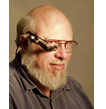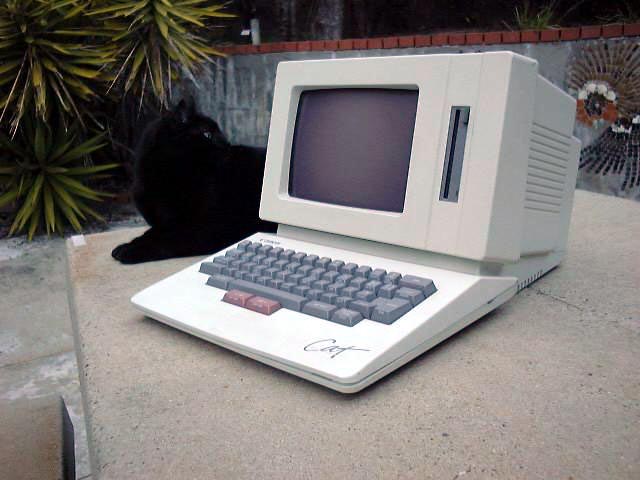Skip to comments.
Jef Raskin, Mac interface expert, dies at 61
CNET News.com ^
| February 27, 2005, 2:05 PM PT
| Steven Musil
Posted on 02/27/2005 3:22:19 PM PST by newzjunkey
Jef Raskin, the human-computer interface expert largely credited with beginning the Macintosh project for Apple Computer, died Saturday at age 61.
Raskin, the author of The Humane Interface, died of cancer, according to a man who answered the telephone Sunday at Raskin's Pacifica, Calif., home.
Raskin joined Apple in January 1978 as employee No. 31, but left the company in 1982 amid a well-documented dispute with Steve Jobs. The Macintosh was launched in 1984.
Reskin was an assistant professor at the University of California, San Diego, and a visiting scholar at the Stanford Artificial Intelligence Laboratory in the 1970s when he first visited Xerox PARC (Palo Alto Research Center). (Apple is often accused of copying Xerox's graphical user interface--GUI--into the Macintosh operating system).
"When PARC was in its first few years I was often a visiting academic there, taking part in discussions and viewing with delight some of the developments going on there; I trust that people there also took pleasure in finding in me someone who was already on much the same user-interface wavelength," Raskin later wrote. "I didn't have to be sold on the idea that UI and graphics were of primary importance to the future of computing."
Raskin said he told Jobs and Steve Wozniak about what he had seen at Xerox the first time he met them in their garage in 1976, and that he stopped visiting Xerox when he went to work for Apple "to avoid any possible conflicts of interest."
Raskin reportedly left Apple after Jobs increasingly muscled in on the Macintosh project.
After leaving Apple, Raskin designed Canon Cat, a small computer with a text-based user interface that did not make use of either a mouse, icons or graphics. Some blamed poor marketing on the part of Canon USA for the computer's short life.
In later years, Raskin worked on The Humane Environment, a system incorporating his interface concepts with open-source elements within a Zooming User Interface.
Raskin earned bachelor's degrees in mathematics and philosophy from the State University of New York and a master's degree in computer science from the Pennsylvania State University.
TOPICS: US: California; US: New York; US: Pennsylvania
KEYWORDS: apple; applecomputer; cancer; canoncat; computerhistory; computerscience; hci; interfacedesign; jefraskin; mac; macintosh; macuser; mcintosh; ny; pa; quickdraw; raskin; stanford; stevejobs; stevewozniak; thewoz; ucsd; xeroxparc
Navigation: use the links below to view more comments.
first 1-20, 21 next last
The article gets the facts wrong. Apple's falsely accused of stealing from Xerox but, in fact, Xerox cut a licensing deal with Apple for Apple stock and made many millions when Apple when public.
It must be made clear Raskin's biggest contribution to Apple was being an evangelist for the notion of bitmap interfaces, rather than a character generator text interface like Apple's classic personal computers and the later IBM PC. He named the project for the McIntosh apple, the spelling was altered for business reasons, but the final product, and it's immediately predessor, the Apple Lisa, had little resemblence to Raskin's vision.
Those projects and what the public at large understands as Macintosh was much the work of other faces, several brought over from Xerox PARC.
Jef Raskin:

The Canon CAT:

DigiBarn's Raskin/Macintosh page
To: Swordmaker
2
posted on
02/27/2005 3:23:03 PM PST
by
cyborg
(http://mentalmumblings.blogspot.com/)
To: newzjunkey
3
posted on
02/27/2005 3:25:05 PM PST
by
Hodar
(With Rights, come Responsibilities. Don't assume one, without assuming the other.)
To: newzjunkey
And what happened to Steve Wozniak?
4
posted on
02/27/2005 3:26:11 PM PST
by
GSlob
To: GSlob
5
posted on
02/27/2005 3:28:27 PM PST
by
newzjunkey
(Demand Mexico Turnover Fugitive Murderers: http://www.escapingjustice.com)
To: GSlob
To: newzjunkey
7
posted on
02/27/2005 3:29:03 PM PST
by
newzjunkey
(Demand Mexico Turnover Fugitive Murderers: http://www.escapingjustice.com)
To: Hodar
Very appropriate graphic.
8
posted on
02/27/2005 3:29:26 PM PST
by
newzjunkey
(Demand Mexico Turnover Fugitive Murderers: http://www.escapingjustice.com)
To: newzjunkey
To: newzjunkey
being a Californian, did you look up the stuff on Raskin, or was u there?
Although not involved in Apple, I was there and met Jef, along with Jobs and Woz, several times each at various events, starting at the First West Coast Computer Faire in San Jose, in 1977. I left the Bay Area around 1982 but am still in the business, on the corporate side (I've "got" 35,000 PCs, oh joy).
Of the three, Woz, Jobs and Raskin, I enjoyed talking with Rasking the most, but hearing Jobs give a presentation the most.
10
posted on
02/27/2005 3:37:53 PM PST
by
Phsstpok
("When you don't know where you are, but you don't care, you're not lost, you're exploring.")
To: newzjunkey
MacFolklore , an interesting resource for relevant history
11
posted on
02/27/2005 3:48:52 PM PST
by
IncPen
( The Problem with Communism (liberalism) is that people like to own stuff - Frank Zappa)
To: Hodar
To: All
That's too bad.
Cancer's a rough way to die, and he was kinda young.
13
posted on
02/27/2005 4:40:21 PM PST
by
tiamat
(Some days, it's not even worth chewing through the restraints.)
To: GSlob
To: Bush2000; antiRepublicrat; Action-America; eno_; N3WBI3; zeugma; TechJunkYard; ShorelineMike; ...
Memorium Mac Ping - Jef Raskin, Mac interface designer dead at 61. If you want on or off the Mac Ping list, Freepmail me.

Jef Raskin
15
posted on
02/27/2005 9:47:31 PM PST
by
Swordmaker
(Tagline now open, please ring bell.)
To: newzjunkey
16
posted on
02/27/2005 9:54:04 PM PST
by
mastercylinder
(Evolution: Taking care of those too stupid to take care of themselves.)
To: Swordmaker
A shame. He was a talented man.
17
posted on
02/27/2005 10:07:27 PM PST
by
Bush2000
To: Swordmaker
Deepest condolences to his family.
One of the kinda nutty ideas Raskin had -- and which made it into the original Mac, but was soon abandoned -- was the lack of cursor keys. The expansion card product Raskin manufactured for the Apple II didn't use or recognize the II's existing cursor keys, even though it was a word processor (in all but name), and the Canon Cat had this same curious deficiency.
Thanks for the ping.
18
posted on
02/28/2005 8:27:38 AM PST
by
SunkenCiv
(last updated my FreeRepublic profile on Sunday, February 20, 2005.)
[snip]
http://slashdot.org/comments.pl?sid=137353&cid=11480678
Re:radical, but not new (Score:5, Interesting)
by binaryDigit (557647) on Wednesday January 26, @10:59AM (#11480678)
Then Jeff partnered with the Cannon [ copier ] company with the CAT-PC.
Yes, I have one, it's an interesting beast. It wasn't so much that the disk was a giant piece of text, what you did was save the entire state of the computers memory onto the floppy. If you wanted to start a new document, then you would simply plop in a blank floppy. The whole thing was written in Forth and there is an "easter egg" that allows you to get direct access to the Forth interpreter.
However the most "novel" thing about it was how you navigated. It didn't use a pointing device (i.e. mouse) but used two dedicated keys on the keyboards labeled "JUMP" (you'll have to forgive me, it's been a while since I've had it out and played with it, so this might not be perfectly correct). You would use the jump keys to "hop" around the document/screen.
There was also an add-in card made for the Apple II that was basically a Cat on a card. If anyone knows of one of these, please let me know. There was also one laptop made, but Jef himself has it and he's not giving it up (or at least wasn't when I asked him about it a few years ago).
[unsnip]
more Canon Cat:
Canon's Cat Computer: The Real Macintosh
http://www.landsnail.com/apple/local/cat/canon.html
more Raskin bio:
http://folklore.org/ProjectView.py?project=Macintosh&characters=Jef%20Raskin&detail=medium
http://folklore.org/ProjectView.py?project=Macintosh&recentcomments=1
19
posted on
02/28/2005 8:46:44 AM PST
by
SunkenCiv
(last updated my FreeRepublic profile on Sunday, February 20, 2005.)
To: newzjunkey; Swordmaker
20
posted on
03/02/2005 8:24:59 AM PST
by
SunkenCiv
(last updated my FreeRepublic profile on Sunday, February 20, 2005.)
Navigation: use the links below to view more comments.
first 1-20, 21 next last
Disclaimer:
Opinions posted on Free Republic are those of the individual
posters and do not necessarily represent the opinion of Free Republic or its
management. All materials posted herein are protected by copyright law and the
exemption for fair use of copyrighted works.
FreeRepublic.com is powered by software copyright 2000-2008 John Robinson


